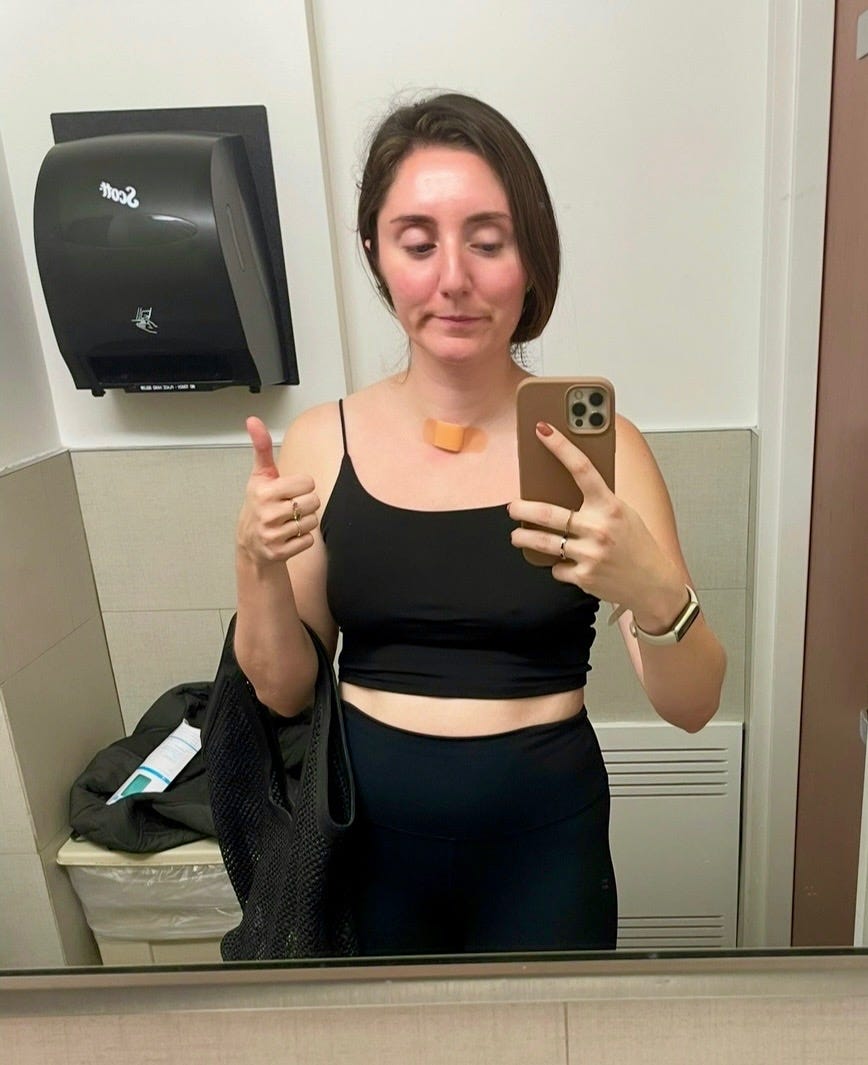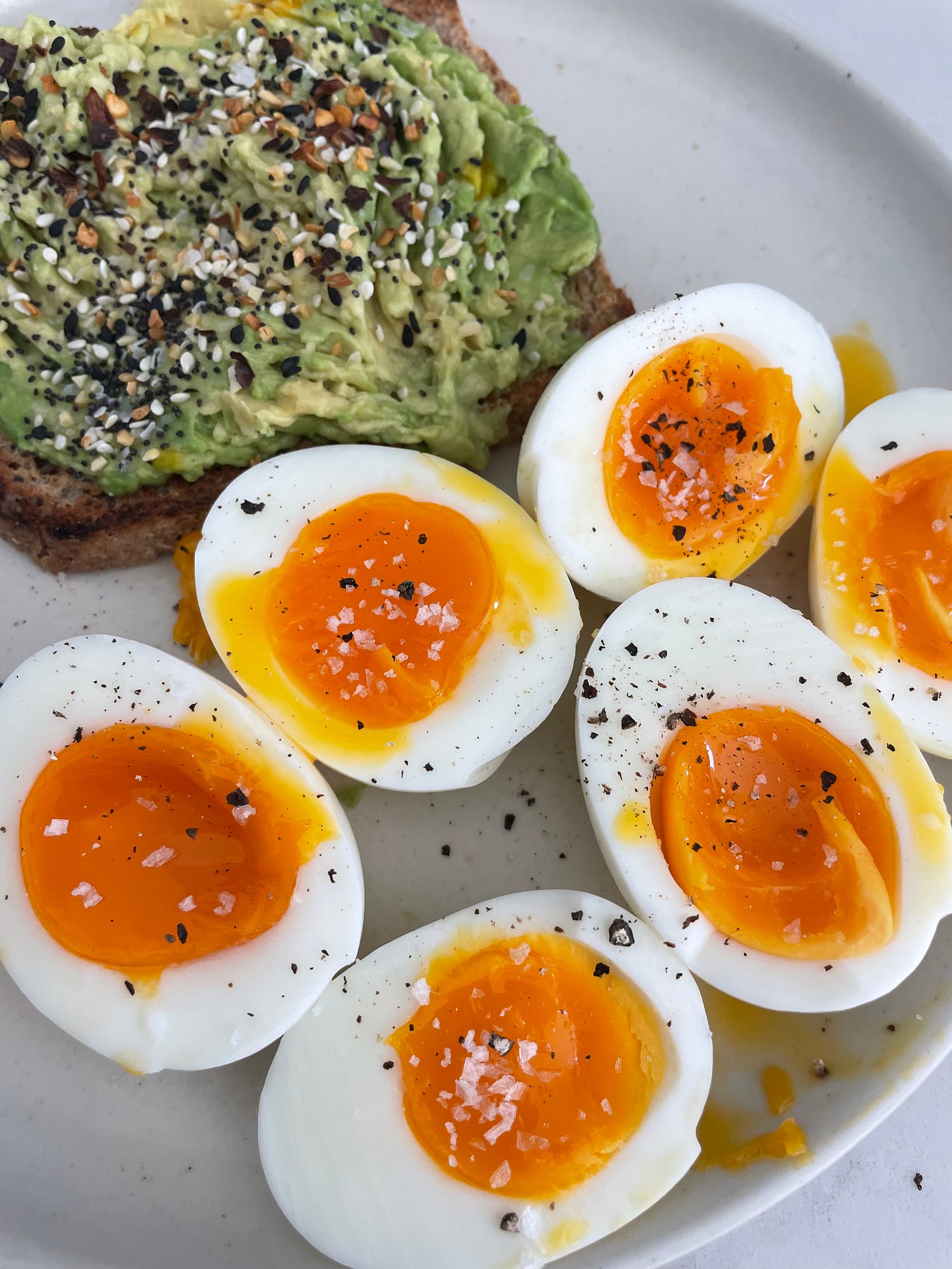The healthcare hamster wheel
"Don't worry," the problem with protocols, and conquering my fear of February.
Welcome to “A little woo,” where I’ll be exploring why the medical establishment is losing smart patients, how to advocate for ourselves without losing our minds, and what happens when startup thinking collides with healthcare bureaucracy. Plus, you'll get honest takes on parenting, startups, wellness, and finding your way when the usual playbook isn't working, from a multiple-time startup exec mom who loves science…with a side of woo. Follow along, subscribe, or send to your friends!
If you’re new here, check out my first post Becoming woo for the backstory on why I started this substack.
Caught in the medical machine
For the first 3 days when I found out about my tumor, I was writing my kids’ future birthday cards in my head. I watched my preschooler, Miles, carefully line up each of his train cars and wondered who would tell him how precise and focused he was so early on. While tickling my toddler, Wes, and hearing his hearty old-man belly laugh, I wondered how to make sure he keeps laughing. At bedtime, when Miles begged for one more cuddle, I cried. This was not rational – thyroid tumors are rarely fatal – but terror doesn't follow statistics.
The full-body MRI company releases your images into their app with their recommendations for follow up steps, and schedules you for a chat with an NP a few days out. Which does mean you are spending these days in limbo and paranoia and swirl, which is one of the reasons doctors don’t like these scans to begin with.
The tumor was on my thyroid, and everything I read reinforced that the obvious next step was a biopsy. I called every endocrinologist in town, and was offered appointments 3 months away. And that was just for a consult, not the biopsy. Even though an MRI is a better imaging test than an ultrasound, the standard protocol dictated you can’t get a biopsy without an ultrasound, and you can’t have an ultrasound without a consult. And endocrinology appointment schedules were booked solid, apparently because of the surge in GLP-1 appointments.
I found myself begging front desk workers all over town, “Please! I have a confirmed baseball in my neck! I just need someone to tell me if it’s cancer.” I asked to be put on waitlists. I asked if they could convert other open appointment types into the one I needed. I asked if there was any possible way to escalate my case. I had worked in healthcare long enough to be annoying, but none of it worked. I then called every doctor I knew, asking if they could help me get a biopsy sooner. I even called the father of one of my 3 year old’s playground friends who was an ENT. Eventually a doctor friend from a former company helped get me in for a biopsy appointment at Mount Sinai. No other steps, direct to biopsy, and just a week away, phew. This is a story about self-advocacy, but it is also one about privilege. I was telling friends, “Even with this much privilege, this is a B- experience.”
The doctor who did the biopsy said the tumor didn’t look suspicious, the “molecular results” would let us know for sure, but either way I should plan for surgery to take my thyroid out (apparently you can’t just take the tumor out). I asked why we’d do that if my thyroid labs were all normal. He said it’s the protocol. I asked why a person with normal labs would get a non-suspicious-looking 6 cm tumor. He said “exposure to radiation like Chernobyl,” with the casual certainty of someone reading from a script. Each question I asked seemed to bounce off a wall of protocol-driven responses.
My results came back “indeterminate,” apparently a very common result, meaning we could neither conclusively say it was benign or cancerous. The only way to know for sure, is to take your thyroid out. Once your thyroid is out, you get put on synthetic thyroid hormone medication for the rest of your life. Again a “don’t worry” - “this is one of the most prescribed medications in the world.”
No one was treating this like a big deal, but it just didn’t make sense to me to be so cavalier about removing an entire organ. I took to the internet. I read that autopsies frequently reveal thyroid cancer in people who died of other causes, like car accidents, meaning the thyroid cancer didn’t kill them. I read studies on the HRAS mutation shown in my results, learning that this mutation has a lot of emerging research that continues to lower the understood risk of malignancy. I found a non profit dedicated to advancing minimally invasive procedures instead of jumping to thyroidectomies. I discovered thyroid patient forums full of stories – some reassuring, others cautionary. Many people do great on synthetic hormones, but many others described years of depression and weight gain before finding the right dose. The more I read, the more I realized the “right” answer was not so clear.

The protocol paradox
The rise of personalized medicine companies – offering full-body MRIs and expanded bloodwork – represents both a solution and a problem. Most doctors actively advise against these services, arguing that they expose things that don't need exposing and trigger unnecessary interventions. (Although don’t get me started on the “waste to the system” argument because there is so much waste in today’s system and patients being “too proactive” is just not the real problem to solve.) There's also often an underlying assumption that non-medical people can't handle medical information reasonably.
But these arguments reveal the real problem: it's not the diagnostic information that's dangerous – it's our rigid, and often narrow, one-size-fits-all response to it. When every finding triggers an inflexible protocol, of course we fear finding anything. What if instead of treating protocols as commandments, we saw them as guidelines to facilitate a personalized conversation? We still haven’t figured out the right way to translate population health principles to individual health needs.
This is not an anti-doctor manifesto – it's a call for a new kind of partnership. We need our doctors' expertise more than ever, but we need it delivered differently. Instead of directive pronouncements, we need collaborative analysis and critical thinking. Instead of protocols that treat everyone the same, we need frameworks that consider the whole person and can handle nuance. It's about demanding medicine that acknowledges complexity, embraces uncertainty, and respects patient agency.
Highlights of the week
A song that’s bringing me joy: Over and Over by Scout LaRue Willis, (yes daughter of Bruce Willis), is a song I am actually listening to over and over. Recommend cranking it loud, closing your eyes, and remembering to breathe.
Conquering my “Fear of February”: ever since going to college in New Hampshire, I’ve noticed I get sort of depressed in February. Call it shortened days, fewer plans, SAD, or not getting outside enough, but daylight savings comes along in March and I rediscover my pre-February personality each time. As a result, I have come to dread February. But here we are, more than halfway through it, and for the first time…I’m fine. The main difference? Prioritizing connection every weekend. Ideally involving getting out of the house. Even if it meant inviting myself over to other people’s homes. Dinner parties, playdates, casual stopovers. Sometimes bringing drinks, my traveling circus of children, or nothing at all. Turns out lots of people want to stay in at the same time that I want to get out. There’s probably another theme here about being proactive about our needs but you can decide. Though probably what’s really happening here is we are all craving more connection, in whatever the form, and winter is an isolating season.
Jammy eggs are back in my rotation: I tend to pick one breakfast, get obsessed with it, overdo it, and then move onto something else. This is not a theme in my life (!!) but does happen with breakfast. Well, I’m back onto an oldie, the once overdone avocado toast + jammy egg. There aren’t a lot of ways to fit this much protein and fiber into your breakfast. Cooking tips will not be my regular content but I also happen to have perfected the jammy egg, behold:
In my next post, I'll share how I triangulated the opinions of various doctors, used my own research to get beyond the standard protocols, and navigated the maze of conflicting advice to chart my path forward. I’ll share the questions I asked, how I weighed different opinions, and most importantly, how I found peace with making an informed decision that worked for me – even when it didn't follow the standard protocol.
"A little woo" isn't about rejecting expertise or going rogue – it's about learning to be an active participant in your own healthcare decisions and being critical of medicine that isn’t personalized. Sometimes that means being the squeaky wheel, and sometimes it means questioning protocols until you understand whether they apply to you.
I’ve enjoyed reading your stories so far - keep ‘em coming! Until next time,
Joanne
P.S. If you found this helpful, consider sharing it with others trying to navigate their own health decisions. And don't forget to subscribe to follow along as we figure this out together.





